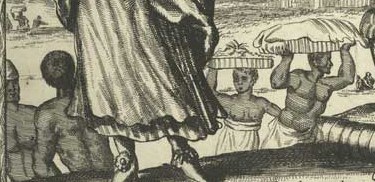
The detail from an engraving above is from the collections of the New York Public Library. The engraver was Aldert Meijer, and there is another very similar image titled Engelse Quakers en tabak planters aende Barbados which was published later. This copper engraving is believed to be one of the oldest representations of New Amsterdam, ca. 1640. It is part of the Stokes Collection: Citation/reference : Stokes P.1642-43, B-10. You can see the whole engraving under the entry on the status of slaves.
August 27, 1627, the DWIC unloaded 22 men from an incoming ship. They became the first enslaved Africans of the DWIC, and many of them are individually documented in this project including the land they were granted in 1644, and their marriages and children whenever possible. Please know that research is ongoing.
Enslaved people in New Netherland had a variety occupations, from very skilled positions to hard basic labor. The DWIC had a separate 'slave house' that was described as being in poor repair, and in 1660 approximately 8 DWIC slaves and their families where living there. One can imagine that it was very crowded, and that the small yard may have had a garden used to help supplement their food.
African enslaved people worked extremely hard, and were responsible for building the wall, and the fort, clearing land, and farming. They came from very warm climates in Congo or Angola in Africa, which are near the equator, and found themselves in a northern city during the Little Ice Age. Undyed, unbleached duffel cloth was made into garments to keep them warm enough to survive the weather. Perhaps some of them had good sewing skills and could make their own clothing from ells of duffel cloth or summer weight Guinea cloth.
See the links below for more information on their importance in the economy and the community.
For more information on Slavery in New Netherland, please see Andrea Mosterman’s digital exhibit for the New Netherland Institute: https://www.newnetherlandinstitute.org/history-and-heritage/digital-exhibitions/slavery-exhibit/ and her book: https://www.amazon.com/Spaces-Enslavement-Resistance-Netherland-Institute/dp/1501715623
For more information please see historian Lavada Nahon’s interview here: https://www.hhlt.org/lavada-nahon/
Alternate views are also available here:
http://maap.columbia.edu/place/30.html - See this link for an article on the 'Land of the Blacks'.
https://maap.columbia.edu/place/31.html- See this link for an article on the building of Fort Amsterdam by 'African Bondsmen'.
http://maap.columbia.edu/place/8.html - This this link for an article on The Great Dock.
After about 1642 in New Amsterdam, some enslaved people were given their "half-freedom." They were free to work on their own, as long as their master did not require their services. When he needed them, they returned to work for him. Both slaves and those with half-freedom were paid by their masters for their work. It was the law. The children of those with half-freedom were not free.
In 1644, eleven slaves petitioned the DWIC for their freedom and it was granted. These men and their wives were given farmland in return for payment of an annual quitrent. They would also be required to serve the DWIC when needed but would be paid for their labor. The children of these eleven would remain DWIC slaves.
So perhaps a more modern term might be partial freedom, with conditions.
However, we do see evidence of manumission of some of enslaved people:
https://encyclopedia.nahc-mapping.org/document/order-petition-domingo-angola
The word slave in English derives from 'Slavonic captive' because so many Slavonic peoples were taken as slaves in the 9th century. Slavery in New Netherland was not restricted to the capture and importation of Africans. Indigenous people called 'Indians' in the documents were also taken as slaves, and ships manifests even show them as having been sent to the Caribbean Islands. This must have been a frequent occurrence because there ere are documents that prohibit the taking of slaves from the Native American Tribes.

